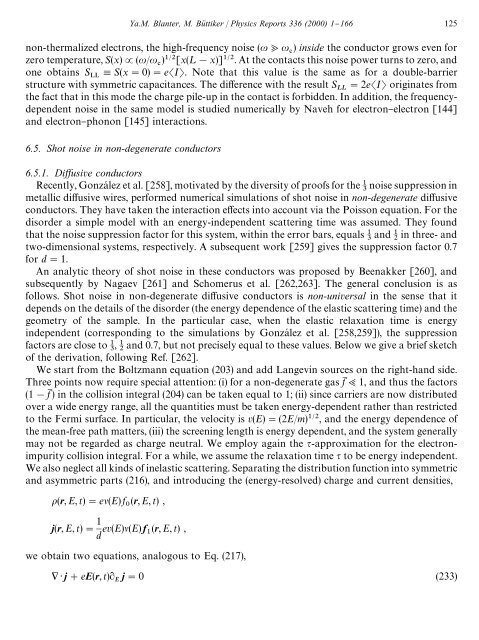shot noise in mesoscopic conductors - Low Temperature Laboratory
shot noise in mesoscopic conductors - Low Temperature Laboratory
shot noise in mesoscopic conductors - Low Temperature Laboratory
Create successful ePaper yourself
Turn your PDF publications into a flip-book with our unique Google optimized e-Paper software.
non-thermalized electrons, the high-frequency <strong>noise</strong> (< ) <strong>in</strong>side the conductor grows even for<br />
zero temperature, S(x)J(/ )[x(¸!x)]. At the contacts this <strong>noise</strong> power turns to zero, and<br />
one obta<strong>in</strong>s S ,S(x"0)"eI. Note that this value is the same as for a double-barrier<br />
structure with symmetric capacitances. The di!erence with the result S "2eI orig<strong>in</strong>ates from<br />
the fact that <strong>in</strong> this mode the charge pile-up <strong>in</strong> the contact is forbidden. In addition, the frequencydependent<br />
<strong>noise</strong> <strong>in</strong> the same model is studied numerically by Naveh for electron}electron [144]<br />
and electron}phonon [145] <strong>in</strong>teractions.<br />
6.5. Shot <strong>noise</strong> <strong>in</strong> non-degenerate <strong>conductors</strong><br />
6.5.1. Diwusive <strong>conductors</strong><br />
Recently, GonzaH lez et al. [258], motivated by the diversity of proofs for the <strong>noise</strong> suppression <strong>in</strong><br />
metallic di!usive wires, performed numerical simulations of <strong>shot</strong> <strong>noise</strong> <strong>in</strong> non-degenerate di!usive<br />
<strong>conductors</strong>. They have taken the <strong>in</strong>teraction e!ects <strong>in</strong>to account via the Poisson equation. For the<br />
disorder a simple model with an energy-<strong>in</strong>dependent scatter<strong>in</strong>g time was assumed. They found<br />
that the <strong>noise</strong> suppression factor for this system, with<strong>in</strong> the error bars, equals and <strong>in</strong> three- and<br />
two-dimensional systems, respectively. A subsequent work [259] gives the suppression factor 0.7<br />
for d"1.<br />
An analytic theory of <strong>shot</strong> <strong>noise</strong> <strong>in</strong> these <strong>conductors</strong> was proposed by Beenakker [260], and<br />
subsequently by Nagaev [261] and Schomerus et al. [262,263]. The general conclusion is as<br />
follows. Shot <strong>noise</strong> <strong>in</strong> non-degenerate di!usive <strong>conductors</strong> is non-universal <strong>in</strong> the sense that it<br />
depends on the details of the disorder (the energy dependence of the elastic scatter<strong>in</strong>g time) and the<br />
geometry of the sample. In the particular case, when the elastic relaxation time is energy<br />
<strong>in</strong>dependent (correspond<strong>in</strong>g to the simulations by GonzaH lez et al. [258,259]), the suppression<br />
factors are close to , and 0.7, but not precisely equal to these values. Below we give a brief sketch<br />
of the derivation, follow<strong>in</strong>g Ref. [262].<br />
We start from the Boltzmann equation (203) and add Langev<strong>in</strong> sources on the right-hand side.<br />
Three po<strong>in</strong>ts now require special attention: (i) for a non-degenerate gas fM ;1, and thus the factors<br />
(1!fM ) <strong>in</strong> the collision <strong>in</strong>tegral (204) can be taken equal to 1; (ii) s<strong>in</strong>ce carriers are now distributed<br />
over a wide energy range, all the quantities must be taken energy-dependent rather than restricted<br />
to the Fermi surface. In particular, the velocity is v(E)"(2E/m), and the energy dependence of<br />
the mean-free path matters, (iii) the screen<strong>in</strong>g length is energy dependent, and the system generally<br />
may not be regarded as charge neutral. We employ aga<strong>in</strong> the -approximation for the electronimpurity<br />
collision <strong>in</strong>tegral. For a while, we assume the relaxation time to be energy <strong>in</strong>dependent.<br />
We also neglect all k<strong>in</strong>ds of <strong>in</strong>elastic scatter<strong>in</strong>g. Separat<strong>in</strong>g the distribution function <strong>in</strong>to symmetric<br />
and asymmetric parts (216), and <strong>in</strong>troduc<strong>in</strong>g the (energy-resolved) charge and current densities,<br />
(r, E, t)"e(E) f (r, E, t) ,<br />
j(r, E, t)" 1<br />
d ev(E)(E) f (r, E, t) ,<br />
<br />
Ya.M. Blanter, M. Bu( ttiker / Physics Reports 336 (2000) 1}166 125<br />
we obta<strong>in</strong> two equations, analogous to Eq. (217),<br />
) j#eE(r, t)R j"0 (233)
















